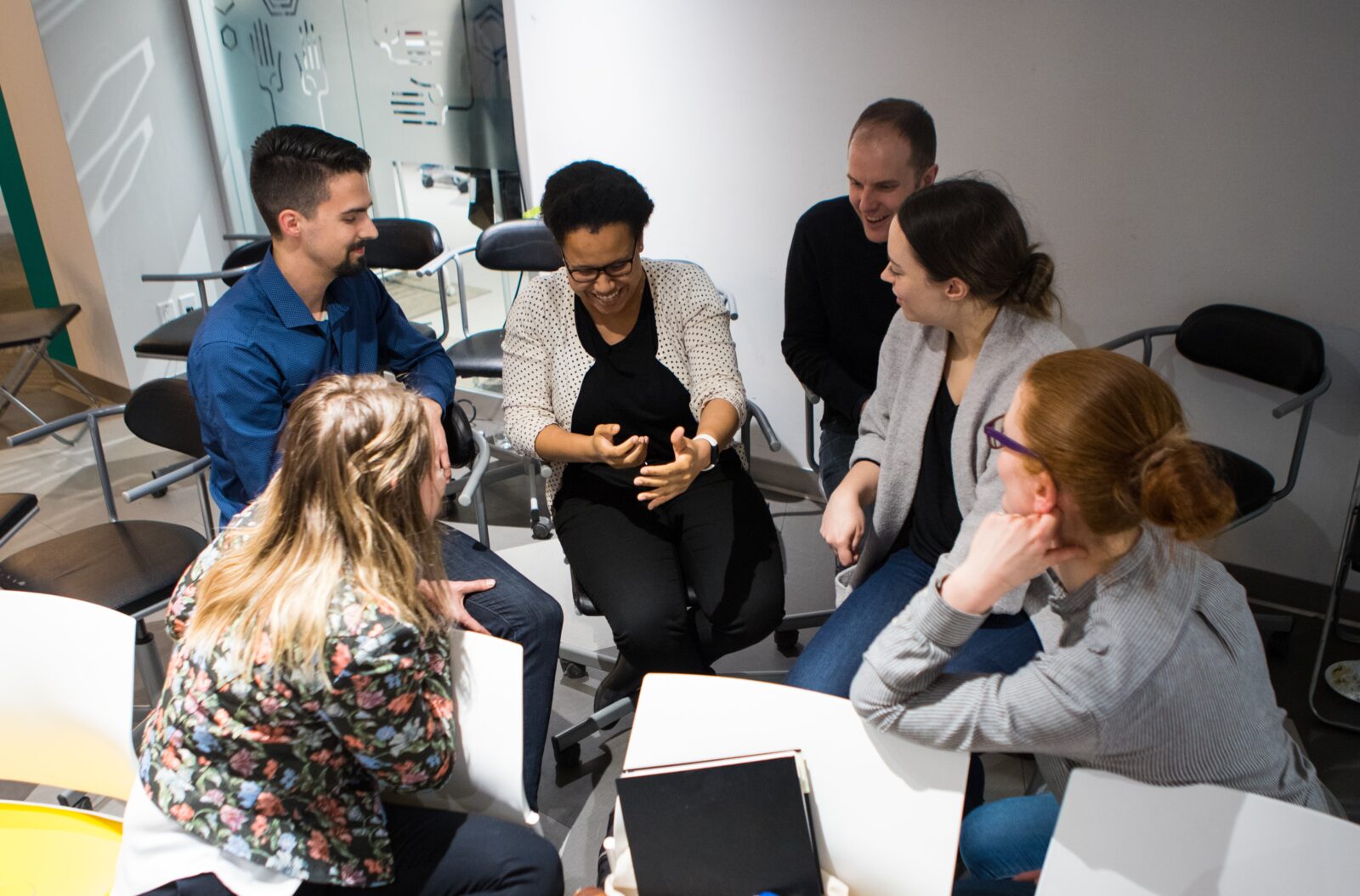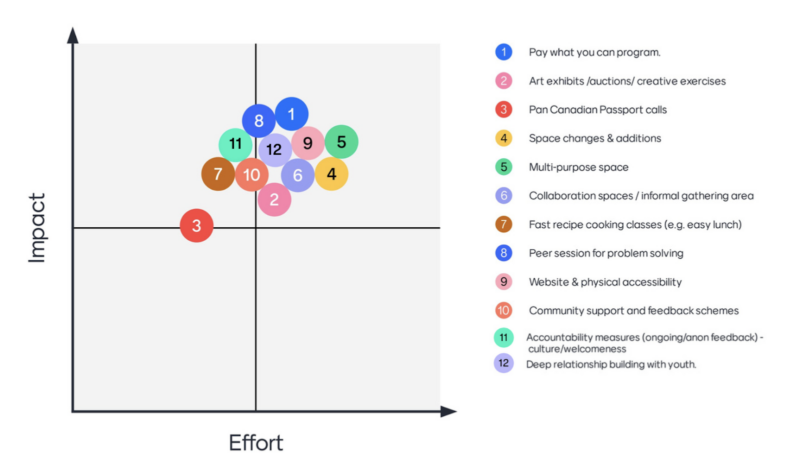
Social Impact Leaders: Stop Building Solutions for People, Build With Them Instead.
Repeat after me: Building solutions for people means building with them first.
Before you roll your eyes and sigh in Overworked Nonprofit Employee Just Trying To Do Their Job, don’t worry: this isn’t another essay bemoaning our sector.
Instead, you’re going to learn how we co-created solutions with our partners, stakeholders, and community members that we’re (gasp!) acting on right away and what it’ll take for you to do the same.
This happened during our second “Co-Designing the Future at the Hub” session, where we built on our first session’s collective vision-making to focus on collective action—because addressing the magnitude of modern sustainability and justice challenges requires collaboration across sectors and diverse communities.
At Impact Hub Ottawa, we know that ours can be the inclusive space and community this cross-sector collaboration needs to thrive, with the United Nations’ Sustainable Development Goals (UN SDGs) as our framework to drive change.
We’re intentional in collaborating with folks marginalized by the oppressive systems that caused these challenges: including Black, Indigenous, racialized people and people of color, people living with disabilities, and 2SLGBTQ+ people.
Because without their insight, we can’t challenge the status quo.
Yet, for these folks to contribute, we need to build brave spaces: where we can acknowledge that in addressing these complex, controversial, and deeply personal problems, we might not all agree, but we will still engage in conversations with trust, openness, and respect.
To make this space real, we partnered with Eva Oloumi—one of our coaches and the founder of Paradeigma. Here’s what we found.
- Want to improve your community engagement, but don’t know where to start? Members can connect with Eva here.
Let’s dive in.
The butterfly effect
Social impact leaders: it’s okay if you’re scared. Your work is heavy, and the risk of making a mistake and causing more undue harm to the communities you want to support is real.
But perfection is impossible.
Instead of letting fear stop you, focus on acting with intention and in collaboration with those you serve—ready to adapt (or pull back) when needed.
Long-term, sustainable change starts with that first step—not that the path to justice is a straight line. It’s a forest: an ever-evolving system sensitive enough to nourish a single idea over decades of care and resilient enough to build new systems where others burned down.
The truth comes out when you ask, not tell
Our first step? Reviewing the visions we made with our community in session one. Usually, this process upholds a hierarchy, where presenters/hosts share their interpretation of results with participants.
But we set up a Gallery Walk instead, where participants reviewed our collective notes from session one along with images that described some of the more complex concepts we discussed.
This gave them the autonomy to tell us what they saw, instead of hearing what we believe, and encouraged them to contribute their perspectives more authentically.
People with different abilities described the challenges of our physical and virtual spaces, learnings we’ve taken to increase Impact Hub Ottawa’s accessibility. Others spoke of financial barriers, and proposed Pay What You Can membership options to break them down.
Many discussed “play,” and how it dismantles hierarchy and facilitates trust, connecting siloed groups while offering a break for those taxed by the weight of social impact work. To facilitate more of these warm, heart-centred connections, we discussed creating friendly, casual spaces.
Building tomorrow’s visions on today’s strengths
Our Gallery Walk showed how we can leverage our current strengths to design our desired future state.
This process, known as Appreciative Inquiry, assumes that every human system has positive elements that make it effective or successful. We broke ours into five steps:
- Discover: The best of what is. What about our in-person or virtual space, networks, services or programs helps advance collaboration on sustainability and justice?
- Dream: The best of what could be. How would an ideal Impact Hub Ottawa better support this collaboration? What are its positive outcomes on the community?
- Design: What should be. What can be done to realize this ideal, through specific changes, initiatives or updates? Who needs to be involved?
- Destiny: What will be. Which decisions from “Design” can we action within our budget and timeframe? What can we invest in long-term?
After exploring them in small groups, each one presented their top two “Destiny” initiatives, graphing them on a scale to prioritize high impact + low effort solutions. Among them:
- Community sessions for problem-solving: Bringing members together in casual sessions to offer support and build community with like-minded leaders.
- Making space for creative play: Friendly, low-pressure, creative group activities, like making easy lunches where our community can bond over food’s unifying/comforting power.
- Processes for accountability, feedback, and support: Implement ongoing and anonymous feedback loops so members can share their experiences and have them carefully reviewed and implemented without fear of retribution.

We’ve also started to execute on high impact, high effort initiatives:
- Creating multi-purpose spaces: Upgrades for more informal gathering and play spaces are underway for people to unwind and deepen relationships.
-
- Increasing accessibility: Making our 6th and 7th floor main entrances fully accessible and upgrading our accessible washrooms.
- Pay-What-You-Can program: Our Compassionate Coworking will reserve funds for people facing financial barriers.
Our future is yours
How do we lay the foundation for a better tomorrow today? With our partners, stakeholders, and community members, we delved into this question in our sessions at “Co-Designing the Future of the Hub.”
Together, we dreamed big and got real about what it will take to make Impact Hub Ottawa a more inclusive space for collaboration to drive justice and sustainability—while our team committed the resources necessary to bring it to life.
In January, we began weaving these insights into the development of our three-year strategic plan, ensuring that our policies and plans are centred on our community’s needs.
But this is just the beginning. To our community: thank you for trusting us. To bring your full self to sessions like these is no small feat, and for your candour, compassion and vision, we are eternally grateful.
Our future at Impact Hub Ottawa is yours.